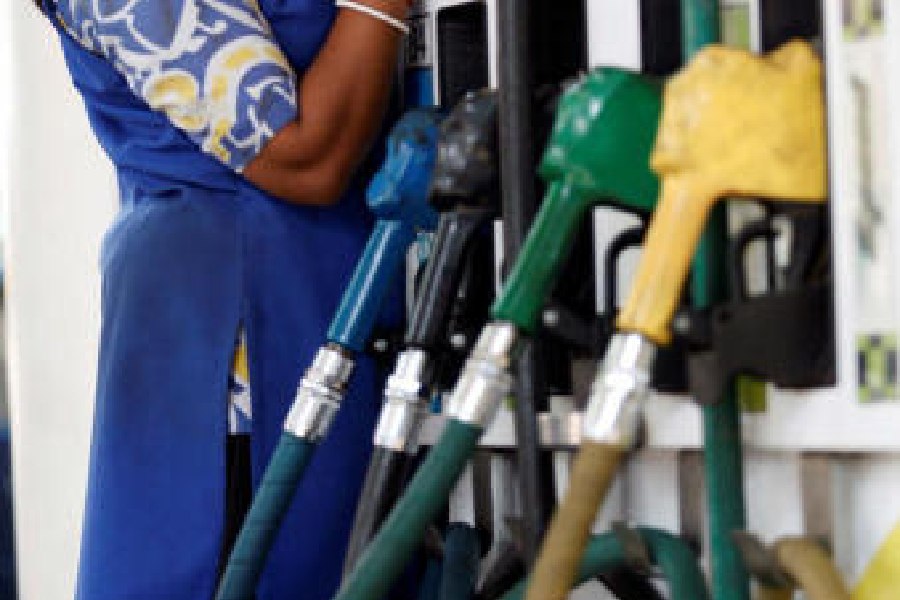Petrol and diesel prices are the costliest in the country in Andhra Pradesh, Telangana and Kerala while it is cheapest in smaller states and UTs like Andaman & Nicobar Islands, Delhi and those in the North East, mainly due to differential in local sales tax or VAT rates, oil industry data showed.
The three state-owned fuel retailers - Indian Oil Corporation (IOC), Bharat Petroleum Corporation Ltd (BPCL) and Hindustan Petroleum Corporation Ltd (HPCL) - last week cut petrol and diesel prices by Rs 2 a litre each, ending a nearly two-year hiatus in price revision.
That reduction brought relief to fuel users but rates continue to be above Rs 100 a litre mark in some states due to higher Value Added Tax (VAT).
Y S Jagan Mohan Reddy's YSRCP-ruled Andhra Pradesh has the costliest petrol at Rs 109.87 a litre, followed by Left Democratic Front (LDF)-ruled Kerala, where a litre of petrol comes for Rs 107.54. Congress-run Telangana is close behind with petrol costing Rs 107.39 a litre.
BJP-ruled states are not far behind - petrol costs Rs 106.45 a litre in Bhopal, Rs 105.16 in Patna (BJP in coalition with JD-U), Rs 104.86 in Jaipur and Rs 104.19 in Mumbai.
Mamata Banerjee's TMC-ruled West Bengal has petrol priced at Rs 103.93 a litre. Other states with over Rs 100-a-litre petrol are Odisha (Rs 101.04 a litre in Bhubaneswar), Tamil Nadu (Rs 100.73 in Chennai), and Chattisgarh (Rs 100.37 in Raipur), industry pricing data showed.
Petrol is the cheapest in Andaman & Nicobar Island where it comes for Rs 82 a litre, followed by Silvassa and Daman where it comes for Rs 92.38-92.49 a litre. Other smaller states too have local VAT, leading to cheaper petrol - Delhi (Rs 94.76 a litre), Panaji (Rs 95.19), Aizawl (Rs 93.68), and Guwahati (Rs 96.12). Most North Eastern states are among the lower-end of the petrol price band.
Diesel prices have almost a similar story with Amaravati in Andhra Pradesh selling the fuel at Rs 97.6 a litre, followed by Rs 96.41 a litre in Kerala's capital Thiruvananthapuram, Rs 95.63 in Hyderabad and Rs 93.31 in Raipur.
The fuel is in the Rs 92-93 a litre range in BJP-ruled sales of Maharashtra, Chhattisgarh and Bihar. It is also in that range in Odisha and Jharkhand.
Diesel is the cheapest in Andaman & Nicobar Island where it comes for about Rs 78 a litre. Delhi - which has the lowest VAT among metro cities - has diesel priced at Rs 87.66 a litre, while in Goa it costs Rs 87.76 per litre.
Commenting on the price cut, Goldman Sachs said the net marketing margin of the three oil marketing companies will decline to Rs 08-09 a litre from Rs 1.7-2.7 a litre.
Morgan Stanley said the price cut "should finally remove a key overhang for fuel retailers".
"The Rs 2 per liter price cut (our estimate was for Rs 2-3 a litre) brings India's fuel basket to USD 85 per barrel Brent crude (i.e. breakeven fuel marketing profitability at this crude price). However, the implied integrated fuel margins for retailers will average 30 per cent above mid-cycle considering the strength in refinery margins," it said.
JP Morgan said the effect of the reduction is equivalent to about a USD 3.5 a barrel increase in crude oil prices. "Although small on headline, a Rs 2 per liter cut will reduce oil marketing companies' revenue / EBITDA by about Rs 30,000 crore annualized." A retail price cut, it said, was expected as the three companies had become highly profitable in the last three quarters, and ahead of general elections due in a few weeks.
"That prices have been cut one-time, and without any signal that pricing goes back to being crude linked (with periodical revisions) can be seen as a negative for these businesses, in our view. Yet, the price cut is relatively modest and seems unlikely to be followed by more (at least near term) - crystallizing the risk for these companies." Emkay Global Financial Services said the price cut translates to a reduction of Rs 1.6-1.7 a litre in gross marketing margins.
"In our view, this cut will be effective for next 2-2.5 months and once national elections are over, we would return to a normalized margin scenario. Deepening deregulation with resumption of daily pricing should likely pass any USD 5-10 a barrel movement in oil prices."
Except for the headline, this story has not been edited by The Telegraph Online staff and has been published from a syndicated feed.











